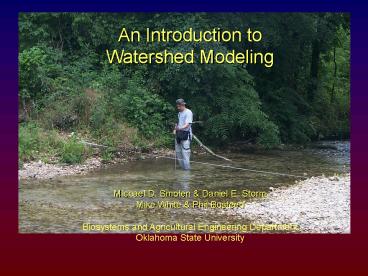An Introduction to - PowerPoint PPT Presentation
1 / 41
Title: An Introduction to
1
An Introduction to Watershed Modeling Micha
el D. Smolen Daniel E. Storm Mike White Phil
Busteed Biosystems and Agricultural Engineering
Department Oklahoma State University
2
What is a Watershed?
- All the land area that drains to a point on the
landscape it can be any size. - Delineated by topography.
- To determine the watershed boundaries, ask the
question, "if a drop of rain lands at a
particular location, which way will it go?"
Watershed Outlet
3
What is a Watershed Model?
A watershed model is a mathematical
representation of the hydrologic cycle, applied
to the watershed.
4
Watershed Model Processes
- Rainfall-runoff and pollutant transport
- Infiltration and ground water
- Evaporation and evapotranspiration
- Crop growth
- Soil and in-stream biological and chemical
processes - Topography, soils, land use, and land management
5
Why Use Watershed Models?
- To evaluate the effects of changing land-use and
management - To target optimal locations for BMPs
- To Identify and quantify pollutant sources
- To determine the overall effect of watershed
management on a receiving water body - To extend the information derived from monitoring
6
Why not just monitor the water?
- Advantages
- Direct measurement
- May identify the smoking gun if there is one.
- Disadvantages
- Expensive and logistically very difficult
- Requires long duration studies for statistical
validity
7
Why not monitor?
- Some things cannot be measured directly.
- In long term monitoring things change.
- A model allows you to isolate the part of the
system that you are interested in. - A model extends the information from monitoring.
8
There are many models available - some are very
specialized.
- SWAT Soil and Water Assessment Tool, developed
by USDA-ARS in Texas - HSPF Hydrologic Simulation Package Fortran,
developed by a Aqua Terra, consultant to EPA - AGNPS Agricultural Nonpoint Source, developed
by USDA-ARS in Minnesota - Many others
9
Soil and Water Assessment Tool (SWAT)
Modeling Objective To predict the effect of
management decisions on water, sediment, nutrient
and pesticide yields with reasonable accuracy on
large, ungaged river basins.
10
Data Needed to Run SWAT
- GIS database - to describe the watershed
(topography, soils, land use) - Time series of weather rainfall, temperature,
solar radiation - Time series of management activities - grazing,
tillage, planting and harvesting, applying
fertilizer or pesticides
11
SWAT Model Operation
- Watershed is divided into sub-basins based on
topography - Land use and soils information is used to define
HRUs (Hydrologic Response Units) - Runoff, sediment, and nutrients are routed from
HRUs through the sub-basins and the stream
network to the watershed outlet.
12
Modeling theLake Eucha Basin using SWAT
13
Lakes Eucha Spavinaw
Livestock Production
- Poultry Integrators Peterson, Simmons, Tyson
- 300 Farms
- 700 Poultry Houses
- 120 million Birds
- 92,000 tons Litter/Year
- Cattle inventory 39,000 hd
14
Modeling Objectives
- Evaluate P loading from nonpoint sources
- Identify sources of P
- Determine relative contributions by source
- Determine point source loading
- Evaluate potential P loading reduction possible
from BMP implementation and watershed management
15
SWAT Input GIS Data
Topography USGS 124,000 DEM
Soils Oklahoma - MIADS Arkansas - County Soil
Survey
Land Use 1100,000 GAP Analysis Project
16
Poultry House Locations and Soil Test Phosphorus
on Pastures in Lake Eucha/Spavinaw Basin
17
Point Source just one
- The City of Decatur - the only point source
considered. - The point source contributes 24 of the total
phosphorous entering Lake Eucha.
18
Nutrient Loading Data from Monitoring
Data Used to Calibrate SWAT Model
19
Three Gauges for Flow Calibration
20
Modeling Results Phosphorus Load Lake
Eucha/Spavinaw Basin
21
Total Phosphorus Load Allocation Lake
Eucha/Spavinaw Basin
22
Best Management Practice Scenarios30-year
Simulation
- 3x current litter application rate increased STP
from 250 to 1300 lb/ac. - Continuing current litter application rate
increased STP by 300 lb/ac. - No application gave a decline of 35 lb/ac.
23
Targeting CriticalSediment and Nutrient
Sourcesin Oklahoma Watersheds
24
Targeting Critical Areas(Stillwater Creek
Watershed)
5 of area (in red) gives 75 of sediment load
25
Modeling theFt Cobb Basin using SWAT
26
Introduction
- Fort Cobb Basin 314 mi2
- Primary land use is row crop and small grain
- Ft Cobb Reservoir 4,100 acres
- Listed on Oklahomas 303(d) List
27
(No Transcript)
28
(No Transcript)
29
(No Transcript)
30
Ft Cobb Watershed
31
Modeling Objectives
- Evaluate sediment loading from peanuts and wheat
- Evaluate P loading from peanuts and wheat
- Evaluate potential P loading reduction from BMP
implementation - Peanuts with Winter Fallow
- Peanuts with Winter Cover
- Wheat with Conventional Tillage
- Wheat with Conservation tillage
32
GIS Input DataTopography from 10 m DEM
33
Sub-basins
34
Methods/Input Land Use Data
35
Flow Calibration and Validation
- Only one suitable flow gage at Cobb Creek near
Eakley, OK (1995-2001) - USGS gage below the reservoir dam was used to
evaluate flow calibration (Cobb Creek at Fort
Cobb) - Flow validation, 1975-1989
36
Flow Calibration Results
Validation Period, lt 6.5 relative error
37
(No Transcript)
38
Modeling BMP Scenarios
39
Uncertainty and Sources of Error
- Simplifying assumptions of the model
- Parameter error measurement error or
calibration error - Processes simplifications, empiricisms, or
incorrect representations - Model structure programming problems
- Input data errors
- Static characteristics e.g. soils, topography,
land use - Dynamic characteristics e.g. land use, climate,
management - Calibration data
- Knowledgeable and trained users essential!!!
40
Modes of Use Absolute vs. Relative Prediction
- Absolute Prediction - What is the expected
concentration or load? - Permit writing
- Implementing water quality standards
- Setting TMDLs
- Relative Prediction
- Determining changes from a baseline condition
- Targeting critical source areas
- Evaluating What If scenarios
- Evaluating BMP implementation
41
Modeling Employs our Best Science in a Rational
Approach































